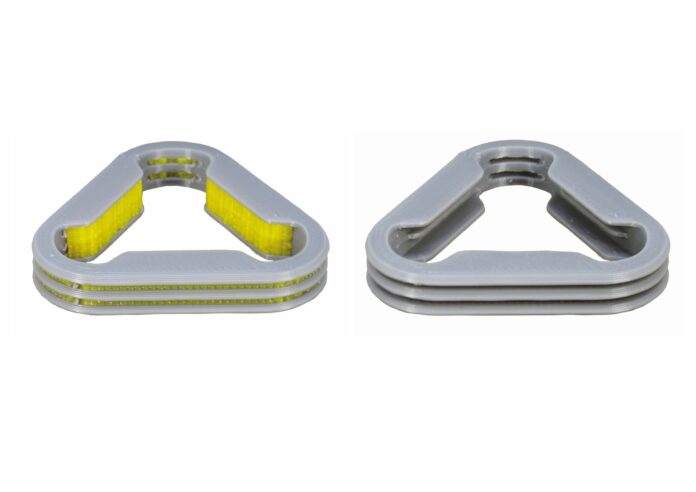The market may have witnessed the shutdown of Silicone 3D printing service bureau Wacker, but companies that still operate on this market show there might be potential to continue exploring this technology.
Following the recent launch of SAM, Spectroplast’ first Silicone 3D printer, 3D printer manufacturer Lynxter announces the release of its silicone 3D printer, named S300X. It is the second 3D printer developed by the company after the S600D.
Like Spectroplast, Lynxter draws on the experience it gathered on silicone 3D printing projects to provide the industry with a 3D printer capable of producing elastomers. Remember what the company did with Erpro and Gaches Chimie, or what they did with De Vinci Innovation Center.
Ideal for the production of medical and industrial grade silicones and polyurethanes, the compact 3D printer allows hollowing and the variation of infill rates to render parts lighter or modify their properties (reduce hardness, add resistance, better damping, from anisotropy to the printed part etc.).
![]() In addition to medical applications (epitheses, protheses, orthopaedics, custom-made devices without taking a manual impression or using a mold), the 3D printer would also meet the requirements of industrial applications (seals, masking, maintenance etc.) as well as R&D applications (prototyping, material formulation, soft robotics).
In addition to medical applications (epitheses, protheses, orthopaedics, custom-made devices without taking a manual impression or using a mold), the 3D printer would also meet the requirements of industrial applications (seals, masking, maintenance etc.) as well as R&D applications (prototyping, material formulation, soft robotics).
The S300X can print a variety of materials including medical grade RTV2 silicone (5, 10, 25, 40 ShA) certified ISO 10993-05 for contact with skin, industrial grade RTV2 silicone (45shA) and polyurethane (from 50 to 85 ShA). These age-resistant silicones require no heavy post-processing and possess mechanical properties equivalent to those of injection molding.
Unveiled along with Lynxter’s own range of materials such as the SIL001 silicone, the printer is said to be developed with an open philosophy – which means that, the machine is likely to process materials from third party suppliers.
Equipped with a LIQ11 single-component toolhead to print the support and a two-component LIQ21 toolhead to print the parts, the S300X is based on the IDEX technology. The two independent extrusion heads make it quick and easy to print complex shapes using soluble support structures. This also paves the way to the combining of materials and the printing of parts with different physical properties in one single print, a press communication reads.
Key technical features include:
- Print volume: 300 x 250 x 200 mm
- Layer height: 100 μm to 1mm
- Calibration: automatic
- Nozzle diameter: Ø0.23mm to Ø1.04mm
- Printer dimensions: W 1000 x L 629 x H 887 mm
- Toolheads: Independent double extrusion
- Support: dissolvable material
- Security: closed filtered environment
- Heated build chamber
Remember, you can post job opportunities in the AM Industry on 3D ADEPT Media free of charge or look for a job via our job board. Make sure to follow us on our social networks and subscribe to our weekly newsletter : Facebook, Twitter, LinkedIn & Instagram ! If you want to be featured in the next issue of our digital magazine or if you hear a story that needs to be heard, make sure you send it to contact@3dadept.com






